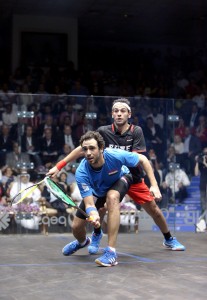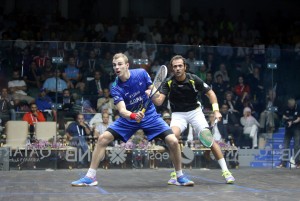
By Richard Eaton
Take a man who isn’t sure he will ever be fit enough to play top squash again, and fly him to Delaware for plasma rich platelet injections for a last ditch remedy for his chronically troublesome hamstrings. Then have him convalesce in New York and keep him away from the pro circuit for six months.
When he’s survived that, plunge him into action at the World Open in one of the toughest fields ever—including the man who won the U.S. Open for the loss of just one game, the fittest, fastest and youngest new world number one since the 1980s.
And then—you know how the fairy tale must go—watch the ailing hero win the world title to widespread amazement. Familiar though the story may be, unless you’d been in Doha in November to see it yourself, you cannot imagine how steep was Ramy Ashour’s climb back to greatness.
He suffered all sorts of physical and mental setbacks. Although he had won the title twice before, the third seemed too far out of reach. He nearly lost long before the final.
To understand you needed to hear his descriptions of the “dark places” he had escaped from, sense the giddy swing of emotions through which he maintained a mental balance, and witness the brilliant patterns that his racquet and movement created.
These made the delightfully extravert Egyptian the most improbable world squash champion of them all. He is also one of the most improbable in any sport. Almost never do athletes spend so much time away from competition and return so instantly to the highest level.

More than that, Ashour’s victory over Mohamed Elshorbagy, the title-winning hero of Philadelphia, the new ranking-topper, and the odds-on favorite, happened in the most exciting of all the thirty-six World Open finals.
Before winning 13-11, 7-11, 5-11, 11-5, 14-12, Ashour was within one point of defeat to his younger compatriot at 11-12 in the final game, averting it with a trenchant and well-timed forehand kill. Elshorbagy was within one point of defeat five times in succession from 5-10 in the final game and six times altogether. During this phase his squash was of the highest order—mentally, technically, and tactically.
It lifted the match to an extraordinary climax, full of multi-patterned rallies and exhilarating changes of fortune. Elshorbagy was a hero too.
He might easily have become world champion for the first time. But before Ashour faced his moment of greatest danger he paused—a hint that the instinctive genius can use thoughtful processes as well as the instinctive forces that produce his high-octane unorthodoxy. These can work brilliantly, but now, one blow from a great failure, Ashour employed a dash of rationality instead.
He also used his brain at two games to one down, when he was increasingly suffering from a painful shoulder that made attacking difficult. He calculated a tactical gamble, moving further up the court more often and using volley drops to intercept with disconcerting frequency.
Finally, he kept his head while so many winning chances came and went—though if you were to believe Ashour himself, he actually lost his head, as he afterwards claimed he could not remember any of the match points at all.
When his last backhand drop shot slipped like a quiet dagger into a defenseless empty space at the death, Ashour erupted. First he tried to walk up the front wall, and then shook himself as though infested by demons, before coiling himself like a fetus on the floor.
“It was dramatic and brutal at the same time,” Ashour said after regaining his sanity. “Both of us were trying to get each other into our own game,” he said, referring to his slowing the rallies down, cutting the ball off, and preventing Elshorbagy from making it a contest of power and pace. “But I don’t think either of us succeeded.”
This made it the most memorable success of his career, despite moments when he almost fell foul of the referee. In a contest decided by such narrow margins, this might have cost him everything.
Once he was warned for taking too long to return to the court; once he was given a code of conduct warning for trying to influence the video review process by talking; and once he was told he would be docked a conduct stroke if he continued to “occupy his opponent’s space”.

But in almost every crisis Ashour found something special. Significantly, according to Elshorbagy, after an extremely error-prone start, Ashour found enough brilliance to haul himself back from 4-9 down to win the first game. That, the younger man thought, had been essential if Ashour were to have a chance of winning.
There had been a major crisis too in the quarterfinals when Ashour had to make his way back from two games down against Borja Golan, the still-improving thirty-one-year-old Spaniard. At this stage Ashour’s movement seemed too limited to get him through this match, let alone the rest of the tournament, yet somehow he managed.
He did it by repelling panic and playing straighter, thus reducing physical stress. Afterwards though, Ashour denied that hamstrings, or any physical difficulties, were a problem. It was his mind that was the problem, he reckoned, preventing him from moving as he could.
These comments caused skepticism, but Ashour’s performance in the semifinal, where he beat Gregory Gaultier—the top-seeded Frenchman—in straight games after a monster first game, suggested he may have been right.
Ashour’s increasing difficulties in this encounter were caused largely by his playing shoulder, which afterwards required prolonged treatment, perhaps because of such a dearth of recent matches. This may have triggered his use of slow-balling in the second half of the final.
After it, Elshorbagy was more than philosophical. “I didn’t do anything wrong,” he said. “I think it’s Ramy’s best performance of the tournament, and I played my best of the tournament as well.”
Elshorbagy had also shown that some pre-tournament comments from his coach, Jonah Barrington, were far-sighted. “Mohamed is incredibly dangerous when he has his back to the wall,” the Anglo-Irish legend said.
“It releases a force of nature which is difficult to handle,” Barrington reckoned, later adding: “There are only a very few, particularly at world class level, who almost always will find a way to respond, even if not successfully. They will fight to the death—and that’s what he does.”
And Elshorbagy did. His capture of the world number one ranking during the U.S. Open was in no way misleading. He showed in Doha, as he had shown in Philadelphia, that over a period of several months he had been the best player.
He ended Nick Matthew’s world title defense in straight games in the semifinals, despite the Englishman having good leads in both the first and third games, and despite a pre-match verbal spat that had created the sort of ambient edge in which Matthew tends to excel.
Throughout the tournament, Elshorbagy’s threat had been a visibly physical one, with persistently fast movement and consistently heavy hitting. These were attributes no other player could quite match.
Matthew nevertheless reached 9-8 in the first game before being upset by an extraordinary refereeing mix-up. Three different decisions were given for the same let appeal, both players came out of the court to argue, and both got the referee to change his mind.

Matthew called it a “complete farce”, and some people agreed. However, the incident involved a normally outstanding referee, and his sequence of uncharacteristic mistakes tended to underline the predicament in which referees often find themselves—made to officiate for too many hours, with too few breaks, and sometimes too much duress as well.
They are also little rewarded, and the issues that were inadvertently raised suggest that the professionalization of referees should soon be high on the agenda. They made the Olympic optimism, which pervaded the tournament and could bring improvement in this and many areas, all the more timely.
For the first time, the World Squash Federation went public with its opinion that a door is still ajar for squash to enter the 2020 Games in Tokyo. A proposed change in the entry regulations would change a cap on the number of sports to a cap on the number of competitors.
This could allow another sport, or sports, in, although the outcome will not be known at least until February. The outcome of the attempt on Geoff Hunt’s record as the oldest male world champion did, however, become clear.
It now seems likely to survive even longer than it already has. The superbly athletic Australian won the last of his four world titles, at the age of thirty-three years and six months, as far back in 1980. Still fit and coaching at age sixty-seven, he was there in Doha and watched his record remain very much intact.
Matthew, aged thirty-four and four months, had been playing well enough to become a serious contender once again but, after the Englishman’s semifinal loss to Elshorbagy, the odds shifted towards Hunt’s record being safe for perhaps another decade.
Amr Shabana, aged thirty-five, had also been playing well enough to have a shot at the record. He beat Max Lee of Hong Kong, the first Chinese player to reach the top-20, much more comfortably than he had in his five-game thriller in Philadelphia.
But in the quarterfinals Shabana found Matthew close to his best and was outplayed, and the four times former World Open champion may find it hard to get any closer to a fifth title now. The Egyptian’s consolation was to have become the only player—the legendary Jahangir Khan and Jansher Khan included—to have reached twelve World Open quarterfinals.
A week with glimpses of the future brought other records too. Egyptians had an interest in six of the last eight matches for the second year in a row. Their domination threatens to become greater than any the game has ever seen.
After Gaultier came from two games down to survive a traumatic first round against Andrew Wagih, an Egyptian qualifier, there were four French players in the second round for the first time. At the top level France could supersede England as the leading European nation.
Meanwhile, a Hong Kong player reached the third round for the first time—thus affecting the sport’s image in China, one of its biggest growth targets—and Steven Coppinger became the first South African in the last eight since Roland Watson in 1979 after beating two seeds. The squash family is growing.
Fully fifteen nations were represented in the last thirty-two. The age range spanned eighteen years. A German, a Swiss, and a Colombian all caught the eye. The diversity was appealing, the TV images exceptional, and the mood newly hopeful. But nothing matched the wonder of Ashour’s comeback.





